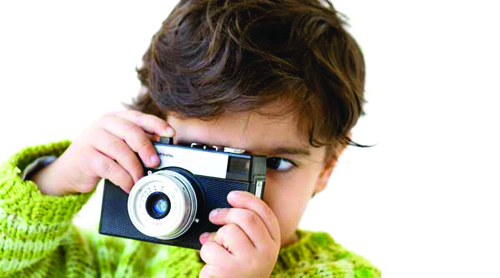
OR


Usha Pokharel
Usha Pokharel is an educationist and author of several children’s books.usha@pokharel.net
For parents, attempting to harvest their children’s creativity through photography is a real challenge. Yet, you can always give them a camera and see how it works out
For today’s generation, festivities and vacations are incomplete without pictures. That includes selfies with a funny pout. One does not have to be an expert for taking pictures these days. Carrying a camera, stand or any other paraphernalia is only for professional photographers. Gone are the days of various types of lenses, apertures, exposures or even film, the type of film or developing them even for the general public. Almost everything is digital these days. Life is simple with all the editing tools at our fingertips. With the introduction of smartphones, taking pictures is as easy as saying ‘cheese’. Since camera phones came into existence commercially in 2002, life has changed. Anyone with a smartphone has access to a camera. Naturally, most of our children have no idea of proper photography, unless they are studying photography as a subject in their school.
Those were the days
Today’s children have no idea taking a picture was not always easy. I still remember the pains a photographer went through to get the best picture. Any mistake on his part would result in a wasted film and bad photo. Just the thought of a person crouched on the floor covered by a black cloth and pointing to the flash of the camera and yelling ‘look at the birdie’ brings a smile to my face.
Those were wonderful days. At the time children did not have access to a camera. It was considered too expensive for children to handle. Now times have changed. Mobiles are all over the place. Today’s parents are least concerned about giving it to their child. At the time the use of the camera was limited to taking pictures of people. When films were used, only the professionals took pictures of other things, and captured them beautifully using their imagination. Now that every smartphone has a camera, taking pictures has become easy and it does not matter how many you take, since films are not involved and you don’t have to wait for ages to have them developed.
Taking pictures is an art. Each person’s perception is different. We all look at the world differently through different lenses and children are no exceptions. They look at the world through a special lens. If you have noticed your children taking pictures, you will notice their pictures are from a different perspective reflecting the purity of their imagination, something most adults lose with age. Children view the world and life around them from a very different perspective. For parents, attempting to harvest their children’s creativity through photography is a real challenge. Yes, you can always give a camera to your child and see how that works out. I know you are thinking, ‘what good is it if they don’t understand the basics of photography?’ I embarked on learning the basics of photography and found the following tools that helped me.
Teach them to click
I am sure it will help you too to introduce photography to your children this vacation season. The first thing to keep in mind is to make it fun. After all, you want them to have fun and learn the basics, so that one day they would be great photographers and even consider studying photography as a subject. If the fun part is missing, they will be bored quickly, and all your efforts will be wasted. Next, give a camera to your child to make them comfortable and confident in handling a camera. The type of camera depends on your child’s age. For elementary school children, you can give them plastic use-and- throw kind of camera. For your middle and high school children, you can encourage them to use their cell phone camera.
To start with, try to simplify everything. I know adults have a habit of complicating everything. First, we need to get out of this mindset and be very clear that children easily understand single concepts. Start with the basics of properly holding a camera. Make sure your child’s camera is equipped with a neck or wrist strap. Always emphasize on wearing the strap to keep the camera safe. Once you feel your child is comfortable with the camera, teach him/her to bring the camera up to his/ her face while keeping his/ her arms tucked in to limit movement.
This is the basic foundation on which you can slowly build other components of your instruction. You can start with the basic concept of ‘fill the frame’ and the ‘rule of thirds.’ The rule of the thirds means that the subject isn’t centered in the image, which is how many new photographers frame their shots. Instead, the main focal point is a bit off to one side. Always make a point of explaining the importance of the concepts. Let them practice and master the idea. Gradually go ahead and explain that other elements can be in the picture for effects. To make it more interesting, focus 70 percent on practicing their skills and 30 percent on the theory. That is because children’s attention span is short, and you need to do the theory part while you can hold their attention. It might be a good idea to give them the whole day to play with their skills and come back in the evening to you for feedback. Encourage them to re-shoot the same thing from a different point of view and different sides. They will realize many things during their photo sessions.
Remember to repeat the concepts in different ways many times so they are clear about the concepts in their mind. Have them repeat the concept back to you, multiple times too. Just keep in mind that kids are kids and won’t get things the way you want them to initially. It’s up to you to keep encouraging them to improve their creativity. Don’t always point out their wrongs, only point out one thing at a time that needs more work on. That way they will not lose hope and continue polishing their photography skills.
Finally, after each session, ask them to point out the pictures they liked the most and ask why. You can even help them by giving hints as to which ones are “most colorful” or “most interesting”. If you agree with your child’s selection, have them printed and put them in a small album for them to proudly show around. That will encourage them the most. You never know this small initiative on your part might change your child’s future. I know not everyone is born to be a teacher. Yet, you can try and invest in your children’s lives and inspire them to be creative artists.
Pokharel is an educationist and author of several children’s books
usha@pokharel.net
You May Like This

Bitten by the creative bug
If you like to keep yourself abreast of what’s happening in the fashion scene in Nepal, you might be familiar... Read More...

Travel photography tips and tricks
Travel and photography have become almost synonymous in today’s world. Taking pictures to document your travels has become a norm,... Read More...

Traffic police to use drone camera to monitor Kathmandu's traffic
KATHMANDU, Jan 13: The Metropolitan Traffic Police Division (MTPD) is bringing a drone camera into use for effective traffic management... Read More...






Just In
- MoFAGA transfers 8 under secretaries and 11 section officers (with list)
- PM Dahal arrives in Morang
- DDC pays Rs 480 million dues to farmers
- Police arrest seven Indian nationals with 1.5 kg gold and Rs 14.3 million cash
- Gold price increases by Rs 1,400 today
- Kathmandu continues to top the chart of world’s most polluted city
- JSP Central Executive Committee meeting today
- Ambassador Adhikari presents his letter of credentials to Turkish President Erdoğan











Leave A Comment